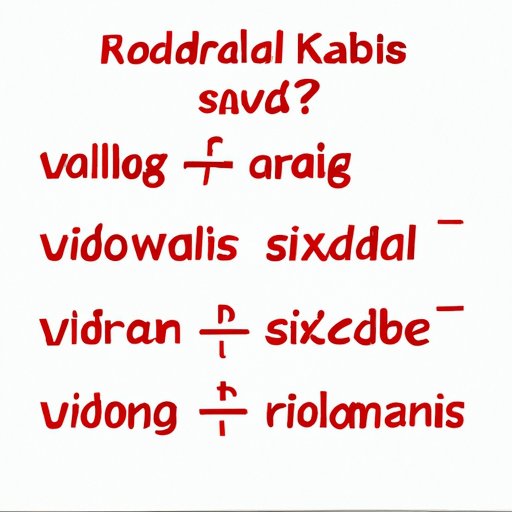I. Introduction
Radicals are a fundamental part of algebraic equations, and simplifying them is crucial for understanding those equations. Radicals are mathematical expressions that involve roots, such as square roots or cube roots. However, simplifying these expressions can be tricky, especially when they involve non-perfect square roots. This article is a comprehensive guide that will help you learn how to simplify radicals to better master algebraic equations.
II. What are Radicals?
Radicals are mathematical expressions that include roots. A root is a number that, when multiplied by itself a certain number of times, equals the original number. For example, the square root of 4 is 2 because 2 multiplied by itself equals 4.
In algebraic equations, radicals are usually denoted by the symbol √. For instance, x = √4 is the same as x = 2, since 2 multiplied by itself equals 4.
III. Rules for Simplifying Radicals
There are several rules that can be applied when simplifying radicals, such as:
- Radicals can be simplified by factoring out perfect squares from their argument
- Radicals with the same index and radicand can be combined or added together
- Radicals can be simplified by rationalizing the denominator, which involves converting a radical that appears in the denominator of a fraction into a whole number or vice versa
When simplifying expressions that involve both perfect and non-perfect square roots, it’s important to recognize them. Perfect square roots are radicals whose square roots are whole numbers, such as √4, √9, or √16. Non-perfect square roots are, as the name suggests, roots where the square root is not a whole number, such as √2, √5, and √10. To simplify radicals with non-perfect square roots, we must use approximation methods.
Examples of these rules in practice include simplifying expressions like:
- √12 = √4 x 3 = 2√3
- √24 + √6 = 2√6 + √6 = 3√6
IV. Step-by-Step Guide to Simplifying Radicals
Here is a step-by-step guide to help you simplify radicals:
- Factor the number under the radical sign into its prime factors
- Find the perfect squares among these prime factors
- Write the perfect squares as their square roots outside the radical sign and group the remaining factors inside the radical sign
- If the radical is in the denominator of a fraction, you need to rationalize the denominator by multiplying the fraction by the conjugate
Here’s an example:
Simplify √75
- Factor 75: 3 x 5 x 5 = 3 x 5²
- 5² is a perfect square
- √75 = √(5² x 3) = 5√3
It’s important to learn how to recognize perfect squares to help simplify radicals. This is because finding perfect squares helps to reduce the size of the factors in the radical. Practice exercises are a great way to solidify your understanding of this skill.
V. Real-World Applications of Simplifying Radicals
Radicals are used in many fields, including construction and engineering. Contractors and engineers need to be able to calculate the size of materials they need to use, such as a tile or wire. This involves calculating areas, volumes, and lengths of shapes, which often involves using square roots. For example, if you want to know how many tiles you need to cover a floor, you need to know how to calculate the square footage of the space. Being able to simplify radicals is an essential part of these calculations.
Learning how to simplify radicals can help develop problem-solving skills, not just in algebraic equations but also in practical applications. Being able to solve real-world problems is one of the benefits of mastering these skills.
VI. Tricks and Tips for Simplifying Radicals
Here are some tips and tricks for simplifying radicals that you can use:
- Memorize your perfect squares up to 15 or 20 to make it easier to recognize them
- Use estimation to simplify non-perfect square roots. To do this, find the two perfect squares nearest to the radicand and then choose the one that is smaller. Multiply the radical by the square root of that square, and simplify if needed
- Recognize patterns in the numbers you are working with to help simplify the expressions. For example, √96 = 4√6 and √242 = 22√2
It’s also important to be aware of common mistakes that students make when simplifying radicals, such as forgetting to simplify the radicals or square roots simultaneously, not recognizing perfect squares or distributive property, and making arithmetic mistakes. Practice exercises are an excellent way to avoid these mistakes.
VII. Comparing and Contrasting Different Methods
There are several methods to simplify radicals, such as factoring, estimating, rationalizing the denominator, and using the distributive property. Each method has its pros and cons, and it depends on the problem you are solving. For instance, using the distributive property may be faster in some cases than factoring out perfect squares, while rationalizing the denominator would make certain fractions easier to work with. It’s essential to learn when to apply each method.
VIII. Conclusion
Simplifying radicals can be challenging, but with practice, it can be mastered. Factoring out perfect squares, recognizing patterns, and knowing when to apply each method are all important skills. Practicing problem sets and real-world applications is the key to honing these skills and becoming more confident in algebraic equations.
